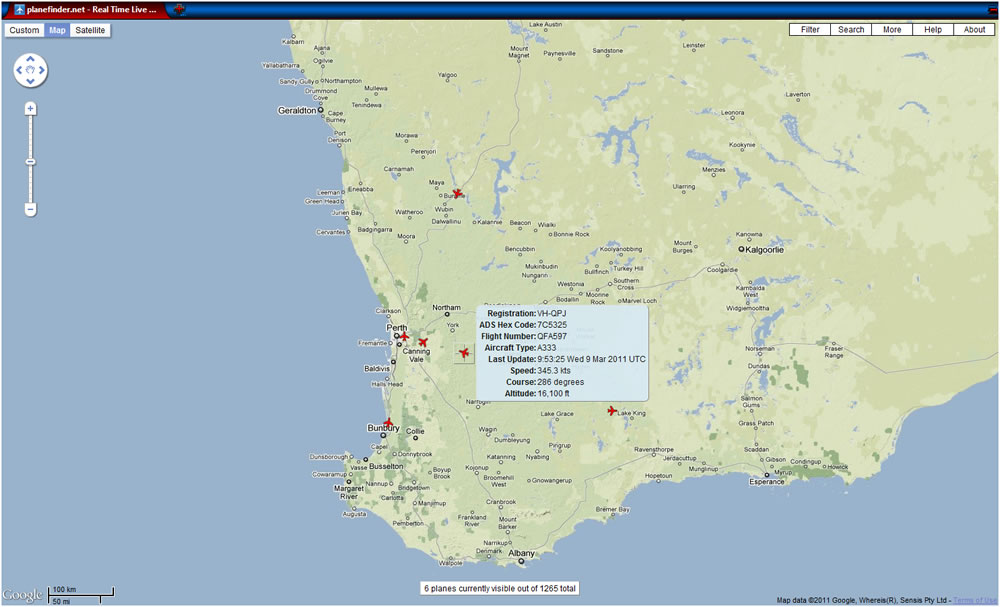Planefinder.net
Planefinder.net shows live aircraft traffic from different parts of the world. Only aircraft equipped with an ADS-B transponder and within the coverage area of their receivers are visible on the map. Not all aircraft are yet equipped with ADS-B.
To obtain details of a particular aircraft, hover your mouse over it and the screen will display the flight number, registration, type of aircraft, altitude, ground speed, track (heading), and route. If you click on an aircraft it will show the flightpath that the aircraft has flown. If you wish to view traffic in the eastern states and other parts of the world by zooming out and dragging your mouse across the screen.
|
ADS-B: Why some aircraft don't show, and WA’s leading role in the next phase
 Some of you may be familiar with excellent websites such as Planefinder.net, which show a live radar-like picture of aircraft in various parts of the world (including the southern half of WA). Some of you may be familiar with excellent websites such as Planefinder.net, which show a live radar-like picture of aircraft in various parts of the world (including the southern half of WA).
LEFT: Screen image from Planefinder.net. (Courtesy: Planefinder.net)
A recent article in the respected aviation magazine Aviation Week & Space Technology
discussed Australia’s pioneering role in the operational use of ADS-B (Automatic Dependent Surveillance-Broadcast), but also mentioned that Western Australia is set to lead the way in the next expansion of the system.
The article included some interesting information on the reasons why some Australian and foreign aircraft do not show up on Planefinder.net.
For those who don't know, ADS-B is an air traffic monitoring system which enables air traffic controllers and other pilots to track aircraft without the need for expensive ground-based radars. The system includes ground stations and requires aircraft to be equipped with the necessary avionics. ADS-B shows the aircraft registration, type, flight number, speed, altitude and course, based on GPS information transmitted by a Mode S transponders. CLICK HERE for detailed description of the system.
Aircraft currently equipped with ADS-B:
More than 70% of the international aircraft using Australian airspace are now ADS-B equipped. Only 20-30% of domestic aircraft are equipped, but this will rapidly increase.
- Qantas:
- Airbus A380s, A330s and Boeing 747-400s – already meet the ADS-B standard.
- Boeing 767-300ERs – Qantas is to modify 17 (out of 26) of the youngest 767s for ADS-B. Some 767s will be phased out, but more may be retrofitted.
- Boeing 737-800s – all new/recent 737-800s are ADS-B equipped. 15 earlier 737-800s are being fitted with ADS-B by 2012.
- Boeing 737-400s – due to be retired. Will not be ADS-B equipped
- Jetstar:
- Airbus A330s – all ADS-B equipped
- Airbus A320s - around 75% are ADS-B equipped.
- Virgin Blue is expected to have a large turnover in its domestic fleet by 2013, which will help boost the domestic ADS-B percentage.
Benefits of ADS-B:
There are a number of operational and safety benefits in using the system:
- Refresh rate of ADS-B positions is twice per second, versus 8 second updates for radar.
- Controllers can now see air traffic over the whole of Australia, which helps to prevent the risk of collisions and permit easier diversions/rerouting for bad weather in remote areas.
- Reduced separation distances (5 nm, versus the previous 30 nm), allowing more flexibility to handle airspace congestion.
- User-preferred routing (UPR) - will allow ADS-B equipped aircraft to re-route during flight to take advantage of better wind conditions and reduce fuel burn. This makes it easier for aircraft to take advantage of the jetstream on eastbound flights, and avoid it westbound.
- Altitude changes more easily approved, allowing aircraft to fly at optimum altitudes to save fuel. A passenger jet will burn 1-1.5% more fuel if it is flying 2,000 ft or more off its optimum altitude.
- Much cheaper than setting up full radar coverage.
Airservices Australia began using ADS-B in 2004, and the country was fully covered by December 2009, but only for upper airspace above Flight Level 290 (29,000 feet). Australia also shares ADS-B data with Indonesia where their airspaces meet. Use of ADS-B below FL290 is currently being debated, as it will impact regional airlines and GA companies, who say that they cannot offset the cost of ADS-B equipment through efficiency gains.
ADS-B rollout:
- All aircraft in Australia’s upper airspace (above FL290) must be ADS-B equipped by 2013. (This is mandatory already).
- Aircraft in airspace over FL110 within 500 nm of Perth will all be required to have ADS-B by the end of 2015. WA is leading this due to heavy air traffic caused by the growth of the resources industry.
- By the end of 2017, this requirement will include Class C, D and E airspace (i.e. all controlled airspace around major and medium-size airports, and the busy mid-level airspace along the East Coast), and Class G airspace (i.e. uncontrolled airspace over most of the country) above FL110.
- From 2020, ADS-B will be required at all altitudes around regional airfields with scheduled service.
|

 Some of you may be familiar with excellent websites such as Planefinder.net, which show a live radar-like picture of aircraft in various parts of the world (including the southern half of WA).
Some of you may be familiar with excellent websites such as Planefinder.net, which show a live radar-like picture of aircraft in various parts of the world (including the southern half of WA).